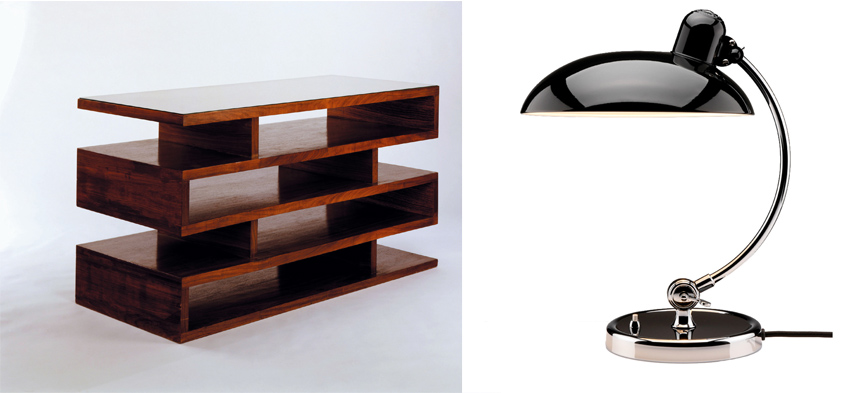Table Of Content
- Bauhaus Interior Design: Everything You Need to Know About the Geometry-Minded Style
- Architect-designed furniture
- Ten of the most iconic pieces of Bauhaus furniture
- What are the defining characteristics of Bauhaus architecture?
- Eight home interiors where mezzanines maximise usable space
- Bauhaus Architecture: Characteristics, Influences, Ambassadors and Sights
- Light Prop for an Electric Stage (Light Space Modulator)

The Wassily chair, the Barcelona chair, and Albers tables are all pieces you can bring into your space to celebrate your appreciation of the style. One of the most famous examples of Bauhaus design is the Wassily Chair designed by architect and furniture designer Marcel Breuer (1928). The chair design was inspired by the tubular metal frame of a bicycle and looks as fresh as it did in 1925 when he first designed it.
Bauhaus Interior Design: Everything You Need to Know About the Geometry-Minded Style
Even before the Nazis came to power, political pressure on the Bauhaus school had increased. The Nazi movement, from nearly the start, denounced the Bauhaus for its "degenerate art" and left-wing political views. The Nazis were also determined to deter all manners of original thinking and put a stop to what it saw as the foreign, probably Jewish, influences of "cosmopolitan modernism." The National Institute of Design, Charles and Ray Eames1961Ahmedabad, IndiaThe couple received an invitation from the Indian government to develop the first design training school in the country. Zentrum Paul Klee, Renzo Piano2005Bern, SwitzerlandGropius was first intrigued by Klee’s work when the latter published “Creative Credo”. He was invited to Bauhaus to give workshops on printing and painting, among many other practices.
Architect-designed furniture
Secondly, the Bauhaus structures are sometimes located in areas that have changed significantly since their construction and may not fit the residents’ or visitors’ current needs and demands. The Hufeisensiedlung (Horseshoe Estate), a housing complex built in Berlin between 1925 and 1933, faces the challenge of adapting to its inhabitants’ modern lifestyle and expectations, such as providing adequate parking spaces, accessibility, and energy efficiency. Thirdly, the Bauhaus structures are often subject to environmental degradation and damage due to their age and exposure to natural elements. The concrete and steel materials used in the Bauhaus buildings can corrode, crack, or rust over time, affecting their structural integrity and aesthetic appeal.
Ten of the most iconic pieces of Bauhaus furniture
His wife Annie Albers studied weaving at the Bauhaus, a choice due to her frailty (caused by Charcot-Marie-Tooth disease). Often mentioned as the most important textile artist of the 20th century, her efforts entered the realm of abstract art with her wall hangings—she even created new textiles. Joseph Albers is best known during his time in the Bauhaus school for his glass pictures in 1928, which utilized glass fragments. His process consisted of sandblasting the glass, painting it in thin layers and baking in a kiln to create a glowing surface. Moholy-Nagy also created sculptures such as his kinetic light and motion machines called “light modulators,” and abstract, geometrical paintings.

In 1928, Brandt would succeed Moholy-Nagy as director of the metal workshop, a testament to the esteem in which she was held by her peers. In the decades since her death, Brandt's designs have become icons of Bauhaus and Constructivist aesthetics. MT 49 "Bauhaus in a Nutshell", a work which exemplifies the school's industrial design aesthetic and emphasis upon functionality. One of Brandt's prototypes for the teapot set a record price for Bauhaus objects at Sotheby's in 2007. It was grounded in the idea of creating a Gesamtkunstwerk ("comprehensive artwork") in which all the arts would eventually be brought together.
LGBTQIA+ Activism in the Arts
Back then, the United States were not yet familiar with the school’s principles and found the house to be remarkably bizarre and out of place. Black Mountain College1933North Carolina, United StatesJust as Bauhaus was closing its doors in Berlin, a school with a similar education program was opening its doors in the United States. The Black Mountain College, which was founded by John Andrew Rice, Theodore Dreier, Ralph Reed Lounsbury, and Frederick Raymond Georgia, was fundamentally different than other design schools in the nation.
Eight home interiors where mezzanines maximise usable space
He envisioned the Bauhaus as encompassing the full totality of artistic media, including fine art, industrial design, graphic design, typography, interior design, and architecture. In 1932 the school moved to Berlin, but it closed a few months later, in 1933, under pressure from the Nazi administration. Many of the students and instructors left the country, dispersing the Bauhaus approach around the globe.
Bauhaus Architecture: Characteristics, Influences, Ambassadors and Sights
These days, it’s hard to imagine scrolling through an Instagram feed without encountering a Wassily chair—if you include all the dupes scattered across the market, that is. ‘Together, we are intending, conceiving and creating the new building of the future …’ Walter Gropius’s founding manifesto is shaped by an educational vision even more than by its architectural and craft vision. The history of the Bauhaus and the development of its programme did not follow a smooth ...
100 years later, Bauhaus school still influential and controversial Daily Sabah - Daily Sabah
100 years later, Bauhaus school still influential and controversial Daily Sabah.
Posted: Thu, 17 Jan 2019 08:00:00 GMT [source]
Light Prop for an Electric Stage (Light Space Modulator)
(German World) highlighted the exhibition and provided some context and history of the Bauhaus movement. Known for his colourful, geometric artworks, Albers applied the same style to the tables, giving each a distinctive colour of blue, red, yellow and white. Designed to be versatile and convenient, the rectangular wardrobe is mounted on castors wheels, making it easy to move into different locations. "Using glass on the staircase to keep a space open and airy and using stained concrete on the countertop to provide durability and beauty are some examples of how Bauhaus concepts are still in use," says Hyman. The Edith Farnsworth House in the United States and the Rose Seidler House in Australia are examples of the residential evolution of Bauhaus. Even brutalist architecture, which emerged at the end of the Second World War, can trace its history back to Bauhaus solidifying the era of modern architecture.
Made from nickel-plated brass and produced by ironmongery manufacturer Izé, the industrial-style door handle comprises a cylindrical grip and a cranked, squared stem. According to Izé, the door handle is the most commercially successful product to emerge from the Bauhaus. With hanging space and shelf storage at the side, and a shoe cupboard inside, the wardrobe is compact and efficient, set in a minimal frame without any complex gadgets. Seven centimetres high, the tea infuser is petite as a result of its function – unlike conventional teapots, it is intended to distill a concentrated extract that, when combined with hot water in the cup, can produce tea of any desired strength. Emily Estep is a plant biologist and journalist who has worked for a variety of online news and media outlets, writing about and editing topics including environmental science and houseplants. During the fourteen years of its existence, the Bauhaus was threatened, contested and persecuted again and again.
Both imagined a place where creative minds could gather, and Bayer took the surrounding landscape and created an architectural response to it. These pieces can be thousands of dollars, so if you’re on a budget, consider some of the many pieces that represent these designs, like the Wassily chair minis or Sean Brown’s Off-White Chairs blanket, which features chairs from many different periods and styles, including the Wassily. Many of Italian metalware company Alessi’s products reflect the spirit of the Bauhaus—even if they weren’t expressly designed by Bauhaus figures, and even though just as many of their pieces are far too spirited to fall in line perfectly with the rational ideals of the Bauhaus.
This naturally propagated the design movement’s ideals across the world in the middle of the century. This conceptual diagram showing the structure of teaching at the Bauhaus was developed by Walter Gropius in 1922. The influence of the Bauhaus can therefore be found in many countries around the world in a variety of forms today, which is a testament to the principles and ideas established 100 years ago. Learn more about the history and characteristics of Bauhaus architecture and design below. Hungarian artist László Moholy-Nagy arrived at the school in 1923 to teach preliminary classes and run a metal workshop, but his real passion was for photography. The Bauhaus aimed to merge art with technically expert craftsmanship through workshops that taught skills such as carpentry, pottery, wall painting, and stagecraft.
Between 1925 and 1926, Walter Gropius, along with students and teachers, created the Dessau University building, an icon of modern architecture and one of the most influential buildings of the 20th century. The Bauhaus, named after a German word meaning "house of building", was founded in 1919 in Weimar, Germany by the architect Walter Gropius. In 1915 he had taken over the Grand-Ducal Saxon School of Arts and Crafts, and it was through the merger of this institution four years later with the Weimar Academy of Fine Art that the radical new design school was formed. In conceptual terms, the Bauhaus emerged out of late-19th-century desires to reunite fine and applied art, to push back against the mechanization of creativity, and to reform education.
At the same time, the development of Russian Constructivism in the 1910s provided a more immediate and stylistically apposite precedent for the Bauhaus's merging of artistic and technical design. Beginning in the mid-19th century, reformers led by the English designer William Morris had sought to bridge the same division by emphasizing high-quality handicrafts in combination with design appropriate to its purpose. By the last decade of that century, these efforts had led to the Arts and Crafts movement. While extending the Arts and Crafts attentiveness to good design for every aspect of daily living, the forward-looking Bauhaus rejected the Arts and Crafts emphasis on individually executed luxury objects.
Fine art became a major offering at the school in 1927 with a free painting class offered by Paul Klee and Wassily Kandinsky. Instruction focused less on function (like so many Bauhaus offerings) and more on abstraction. Expressionism and Futurism would have a noticeable influence on the art produced in the school alongside its specific style of geometric design that at times resembled Cubism. The physical plant at Dessau survived World War II and was operated as a design school with some architectural facilities by the German Democratic Republic. This included live stage productions in the Bauhaus theater under the name of Bauhausbühne ("Bauhaus Stage"). After German reunification, a reorganized school continued in the same building, with no essential continuity with the Bauhaus under Gropius in the early 1920s.[43] In 1979 Bauhaus-Dessau College started to organize postgraduate programs with participants from all over the world.
When the school was forced to close its doors in the face of political pressure, its professors and students dispersed, spreading its teachings across the world. Technology’s role in the modern interpretation and adaptation of Bauhaus architecture allows designers to explore new forms, materials, and functions that reflect the contemporary context and challenges. Bauhaus architecture was originally influenced by the Industrial Revolution and the emergence of mass production, which led to a focus on simplicity, functionality, and standardization. Modern technology, such as digital fabrication, parametric design, and interactive media, enables architects to create more complex, dynamic, and responsive structures that still adhere to the Bauhaus principles of harmony, clarity, and unity. Technology also allows architects to engage with the social, environmental, and cultural aspects of Bauhaus architecture, such as creating spaces that foster collaboration, communication, and creativity.

No comments:
Post a Comment